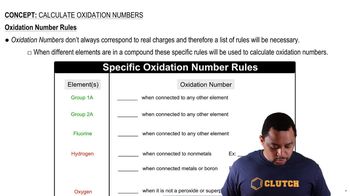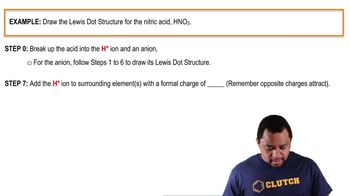Determine the oxidation number of sulfur in each of the following substances: (f) Which region(s) of the periodic table contains elements that can adopt both positive and negative oxidation numbers?
Ch.4 - Reactions in Aqueous Solution
Chapter 4, Problem 49d
Determine the oxidation number for the indicated element in each of the following substances: (d) N in HNO3
 Verified step by step guidance
Verified step by step guidance1
Identify the oxidation number of hydrogen (H), which is typically +1.
Identify the oxidation number of oxygen (O), which is typically -2.
Let the oxidation number of nitrogen (N) be x.
Set up the equation based on the sum of oxidation numbers in the compound HNO3: 1 (for H) + x (for N) + 3(-2) (for O) = 0.
Solve the equation for x to find the oxidation number of nitrogen in HNO3.

Verified video answer for a similar problem:
This video solution was recommended by our tutors as helpful for the problem above.
Video duration:
3mWas this helpful?
Key Concepts
Here are the essential concepts you must grasp in order to answer the question correctly.
Oxidation Number
The oxidation number, or oxidation state, is a theoretical charge assigned to an atom in a compound based on certain rules. It reflects the degree of oxidation of an atom and helps in understanding electron transfer in redox reactions. Oxidation numbers can be positive, negative, or zero, depending on the atom's electron configuration and bonding.
Recommended video:
Guided course

Oxidation Numbers
Rules for Assigning Oxidation Numbers
There are specific rules for assigning oxidation numbers, such as the fact that the oxidation number of an element in its elemental form is zero, and for monoatomic ions, it equals the charge of the ion. In compounds, hydrogen typically has an oxidation number of +1, oxygen usually has -2, and the sum of oxidation numbers in a neutral compound must equal zero.
Recommended video:
Guided course

Oxidation Number Rules
Nitric Acid (HNO3) Structure
Nitric acid (HNO3) is a strong acid composed of one nitrogen atom, three oxygen atoms, and one hydrogen atom. In this compound, the nitrogen atom is bonded to three oxygen atoms, one of which is double-bonded, and the other two are single-bonded to oxygen and hydrogen. Understanding the molecular structure is essential for determining the oxidation state of nitrogen in HNO3.
Recommended video:
Guided course

Lewis Dot Structures: Acids Example 1
Related Practice
Textbook Question
Textbook Question
Determine the oxidation number for the indicated element in each of the following substances: (a) S in SO3 (b) Ti in TiCl4
Textbook Question
Determine the oxidation number for the indicated element in each of the following substances: (c) P in AgPF6
Textbook Question
Determine the oxidation number for the indicated element in each of the following substances: (e) Pt in PtCl4 (f) O in OF2.
Textbook Question
Determine the oxidation number for the indicated element in each of the following substances: (f) Cl in NaClO4.
Textbook Question
Which element is oxidized, and which is reduced in the following reactions? (a) N2(g) + 3 H2(g) → 2 NH3(g)
